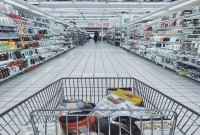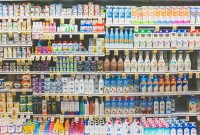- Home
- Business Processes
- Industry Knowledge
- Aerospace Industry
- Automotive Industry
- Banking Domain
- BFSI Industry
- Consumer/ FMCG Industry
- Chemicals Industry
- Engineering & Construction
- Energy Industry
- Education Domain
- Finance Domain
- Hospitality Domain
- Healthcare Industry
- Insurance Domain
- Retail Industry
- Travel and Tourism Domain
- Telecom Industry
- Leadership Skills
- eLearning
- Home
- Domain Knowledge
- Consumer/ FMCG Industry
- Consumer Durable Goods
Consumer Durable Goods
Durable goods are consumer goods that have a long life span (e.g. 3+ years) and are used over time. Highly durable goods such as refrigerators, cars, or mobile phones usually continue to be useful for three or more years of use, and hence durable goods are typically characterized by long periods between successive purchases.
These durable goods are referred to as Consumer Durables and examples of consumer durable goods include cars, household goods (home appliances, consumer electronics, furniture, etc.), sports equipment, and toys.
Characteristics of Durable Goods
Given below are the characteristics of durable goods:
- Durables are also known as durable goods or consumer durables
- Tend to last for at least three years, useful for longer than 3 years
- Durable goods have a long life span and hold up over time, and do not wear out quickly
- Do not have to be purchased frequently, the second purchase for durable goods lags time difference
- Durable Goods are generally sold on a higher margin
Some examples of durables are appliances, home and office furnishings, lawn and garden equipment, consumer electronics, toys, small tools, sporting goods, photographic equipment, jewelry, motor vehicles and motor vehicle parts, turbines, and semiconductors.
The Consumer Durables industry consists of durable goods and appliances for domestic use such as televisions, refrigerators, air conditioners, and washing machines. Instruments such as cellphones and kitchen appliances like microwave ovens are also included in this category.
The sector has been witnessing significant growth in recent years, helped by several drivers such as the emerging retail boom, real estate, and housing demand, greater disposable income, and an overall increase in the level of affluence of a significant section of the population.
The industry is represented by major international and local players such as BPL, Videocon, Voltas, Blue Star, MIRC Electronics, Titan, Whirlpool, etc.
The consumer durables industry can be broadly classified into two segments: Consumer Electronics and Consumer Appliances. Consumer Appliances can be further categorized into Brown Goods and White Goods. The key product lines under each segment are as follows.
Consumer Appliances
A home appliance, domestic appliance, or household appliance is a device that assists in household functions such as cooking, cleaning, and food preservation. While many appliances have existed for centuries, the self-contained electric or gas powered appliances are a uniquely American innovation that emerged in the twentieth century. The development of these appliances is tied to the disappearance of full-time domestic servants and the desire to reduce the time-consuming activities in pursuit of more recreational time. Major appliances, also known as white goods, comprise major household appliances and may include:
- Kitchen Appliances
- Refrigerators
- Washing Machines
- Air-conditioners
- Speakers and Audio Equipment
- Kitchen Appliances / Brown Goods Consumer Electronics
- Mixers
- Grinders
- Microwave Ovens
- Iron
- Electric Fans
- Cooking Range
- Chimneys
Consumer Electronics
Consumer electronics or home electronics are electronic (analog or digital) equipment intended for everyday use, typically in private homes. Consumer electronics include devices used for entertainment, communications, and recreation. Consumer electronic devices such as smartphones, tablets, and laptops are constantly evaluated against three key criteria: low-cost, high-power efficiency and support of communication standards, Given below are some examples of Consumer Electronics:
- Mobile Phones
- Televisions
- MP3 Players
- DVD Players
- VCD Players
- iPad
Related Links
You May Also Like
-
All of us are consumers, from cradle to grave, to be more precise, from the womb to grave or cremation. In a sense, the history of the consumer is the history of mankind. Consumers are the largest economic group in any country. They are the central point of all of our economic activities. But the very same consumers ate the most voiceless group also. The nature of consumer in terms of needs, consumption patterns, and problems has been changing and evolving along with the social and economic development in the course of history.
-
Competitive Landscape of Retail Industry
In an increasingly competitive landscape, retail industry players must compete in a number of ways. In this article, we will learn about the competitive landscape of the retail industry. Learn the key players in the retail industry and their business profile. Learn more about the top 5 industry players. Competition is rough, especially for the small business. Knowing how business stacks up to the competition is important to your business strategy.
-
Durable goods are consumer goods that have a long life span (e.g. 3+ years) and are used over time. Highly durable goods such as refrigerators, cars, or mobile phones usually continue to be useful for three or more years of use, and hence durable goods are typically characterized by long periods between successive purchases.
-
Retail Industry: Current Challenges
Today consumers are choosing multichannel buying experiences and expect that to be a seamless experience. To attract customer loyalty, retailers need to provide an experience that stands out from others. Learn the challenges faced by the retail sector today. Multi-channel sale avenues, changing consumer behavior, technological advances, rising competition, rising frauds, and supply chain management are some of them that require immediate attention.
-
Business Dynamics of Consumer Industry
The consumer goods industry is impacted by many dynamics like economic considerations, product considerations, price considerations that impact consumer buying choices. Advertisements, branding, marketing, variety of goods, and technology are the main drivers. Manufactures, retailers, warehousing, and logistics are all part of the supply chain for the consumer goods industry.
-
Retail Industry: Key Performance Metrics
You cannot manage what you do not measure and cannot measure what you do not define. Learn the key performance metrics for the retail industry like Sales per square foot, Gross margins return on investment, Average transaction value, Customer retention, Conversion rate, Foot traffic, and digital traffic and Inventory turnover, etc. These metrics are used across the globe by key industry players to track and improve their performance.
-
Retail Industry Sectors: Types of Retail
A marketplace is a location where goods and services are exchanged. The traditional market square is a city square where traders set up stalls and buyers browse the merchandise. Now retail goods are generally sold in a number of different establishments. Convenience Stores, specialty stores, department stores, supermarkets & hypermarkets, discount stores, multichannel stores are some models used by the retail industry to provide goods to end customers.
-
The consumer goods sector is a category of stocks and companies that relate to items purchased by individuals and households rather than by manufacturers and industries. These companies make and sell products that are intended for direct use by the buyers for their own use and enjoyment. This sector includes companies involved with food production, packaged goods, clothing, beverages, automobiles, and electronics. Nestle, Procter & Gamble, and Pepsico are some of the world’s largest consumer goods companies in the world.
-
FMCG or consumer packaged goods (CPG) are products that are sold quickly and at relatively low cost, examples include non-durable goods such as soft drinks, toiletries, and grocery items. They generally sell in large quantities, so the cumulative profit on such products can be substantial and these industries often operate on thin margins.
-
Retail Industry - Business Model
A retail business model articulates how a retailer creates value for its customers and appropriates value from the markets. In retail, a business model would dictate the product and/or services offered by the retailer, the pricing policy that he adopts. Many different types of retail establishments exist, and, the overall industry has seen a significant blurring of the boundaries that separated the wide range of retail businesses. Understand the key business models adopted by the retail industry. Understand the distinctive ways that retail industry players use to reach to the end consumer.
Explore Our Free Training Articles or
Sign Up to Start With Our eLearning Courses

About Us
Learning
© 2023 TechnoFunc, All Rights Reserved









